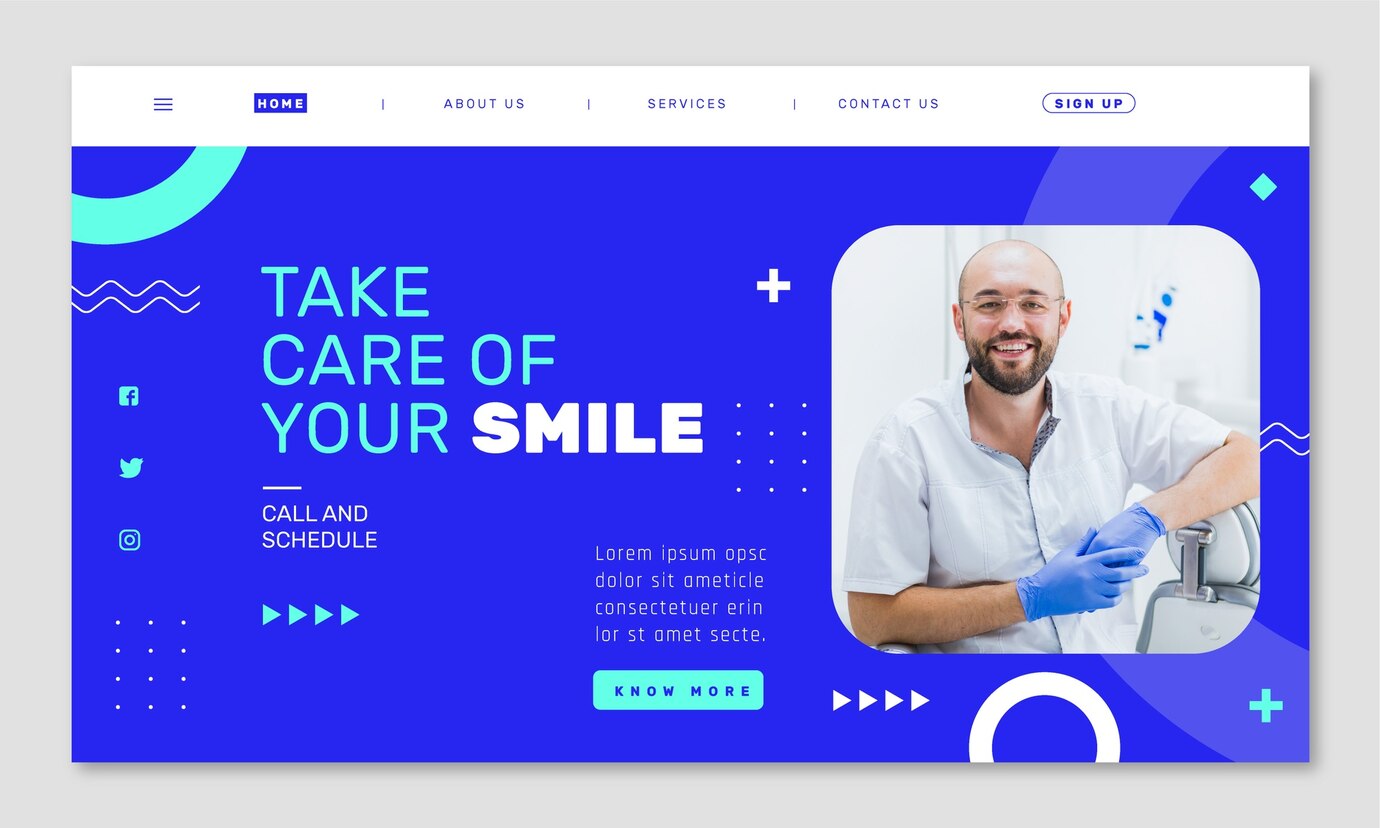7 Powerful Tips for Top Dental Web Design Success
|
When it comes to running a successful dental practice, the power of a great website can’t be overstated. Imagine this: You walk into a dental office, and it’s spotless, modern, and welcoming. Now, picture your website doing the same thing—creating a lasting, positive impression the moment a potential patient visits. That’s the essence of dental web design.
In today’s digital world, your practice’s online presence is often the first point of contact for new patients. So, why not make it count? A well-designed website isn’t just about looking pretty—it’s about functionality, user experience, and ultimately converting visitors into loyal clients.
In this guide, we’ll explore everything you need to know about dental web design, from choosing the right layout to incorporating SEO best practices, and ensuring your site truly represents your practice’s unique personality.
Key Features of an Effective Dental Website Design
| Feature | Description | Importance |
|---|---|---|
| Clean and Professional Design | Simple color scheme, high-quality images, and consistent branding. | Builds trust and gives a professional, welcoming impression. |
| Easy Navigation | Clear and simple menu with options like Services, Contact, and Book an Appointment. | Enhances user experience, making it easy to find necessary info. |
| Mobile-Friendly Design | Adapts to mobile devices and ensures fast load times. | Ensures accessibility for mobile users, improving engagement. |
| SEO Optimization | Incorporates relevant keywords and local SEO practices. | Helps your site rank higher in search results, attracting new patients. |
| Online Booking System | Allows patients to schedule appointments online. | Increases convenience and reduces administrative workload. |
| Patient Testimonials | Showcase reviews and success stories from patients. | Builds credibility and trust with potential patients. |
| Educational Content | Blog posts, FAQs, and dental tips. | Engages visitors and boosts SEO by providing useful, fresh content. |
| Clear Calls to Action (CTAs) | Prominent buttons like “Book Now” or “Contact Us.” | Encourages user interaction and conversion. |
What Makes Dental Web Design So Important?
Let’s be real: the first thing a new patient will judge you on is your online presence. It doesn’t matter how great you are at fixing teeth if your website looks like it was last updated in 2005. Here’s why dental web design is more crucial than ever:
- First Impressions Matter: Think of your website as your digital waiting room. A clean, modern design will give the impression that your office is organized, professional, and trustworthy.
- Ease of Navigation: Patients want to quickly find the information they need, whether it’s your contact details, services offered, or online booking system. A complicated site? Not so much.
- SEO Benefits: A good dental web design incorporates SEO best practices, helping your site show up in search engine results and making it easier for new patients to find you.
- Mobile Responsiveness: With the majority of people browsing the web on their phones, having a mobile-friendly website is no longer optional.
So, what exactly should a dental website design include? Let’s break it down.
Key Features Every Dental Website Needs
1. A Clean and Professional Design

Let’s start with the basics. Your site should be visually appealing, but not overwhelming. Use a modern, clean design that makes it easy for users to navigate without distractions. A great dental website design often includes:
- Simple Color Scheme: Stick to neutral colors like white, blue, or green that evoke cleanliness and trust.
- High-Quality Imagery: Invest in professional photos—pictures of your office, your team, and happy patients can make a world of difference.
- Consistent Branding: Your logo, colors, fonts, and layout should reflect your practice’s values and mission.
2. Clear, Easy Navigation

You want to make it as easy as possible for potential patients to find the information they need. This means:
- Simple Menu: Your main menu should include clear options like “Services,” “About Us,” “Contact,” and “Book an Appointment.”
- Intuitive Layout: Categories should be easy to scan, and important information like contact info or emergency services should be visible without scrolling.
3. SEO-Friendly Content
SEO (Search Engine Optimization) is key to getting found online. Without it, even the best-designed website won’t show up in search results. So, what should you keep in mind?
- Keyword Usage: Use relevant keywords throughout your site, like “family dentist in [city name]” or “best dental care near me.”
- Optimized Content: Each page should have well-written, informative content that answers common questions about your services.
- Local SEO: Make sure your website is optimized for local searches. Add your address, phone number, and service area so you show up in local search results.
4. Mobile-Friendly Design
As of 2024, over half of all internet traffic comes from mobile devices. If your site doesn’t look good or function properly on smartphones, you’re losing potential patients.
- Responsive Design: Your site should adapt to different screen sizes, providing a smooth browsing experience on phones, tablets, and desktops.
- Fast Loading Times: Mobile users tend to leave slow-loading websites. Compress images and optimize your code to make your site as fast as possible.
5. Online Booking System

Gone are the days of playing phone tag with patients. A seamless online booking system is a must-have for any modern dental website. It allows patients to book appointments at their convenience and reduces administrative work on your end.
Enhancing User Experience with Smart Features
1. Patient Testimonials and Reviews
What better way to convince a potential patient that your dental practice is the right choice than by showcasing what your current patients think? Incorporating patient testimonials on your website builds trust and helps convert visitors into actual clients.
- Include a Testimonials Section: Dedicate a part of your website to positive reviews and success stories from your happy patients.
- Link to External Review Platforms: Encourage satisfied patients to leave reviews on Google or Yelp, and link to these platforms directly from your site.
2. Educational Blog or Resources
A blog or resource center is a great way to engage with patients and provide valuable information about dental care. It’s also an excellent way to improve your SEO by regularly adding fresh content with targeted keywords.
- Share Dental Tips and Advice: Write posts about common dental problems, preventative care, or new treatments you offer.
- Answer Frequently Asked Questions (FAQs): Dedicate a section to FAQs, providing answers to common concerns about your practice.
3. Clear Calls to Action (CTAs)
Your website should guide visitors toward taking the next step. Whether it’s calling for an appointment or signing up for a newsletter, clear calls to action are crucial.
- Book an Appointment Button: Place this button prominently on every page, especially the homepage and service pages.
- Contact Us: Make sure your contact form is easy to find and use. If you offer consultations, a “Schedule Consultation” CTA is a must.
Common Mistakes in Dental Web Design (And How to Avoid Them)
Now that you know what makes a great dental website design, let’s talk about some common pitfalls to avoid:
- Too Much Text: Your visitors don’t want to read a novel. Be concise, clear, and to the point.
- Complicated Navigation: If users can’t find what they’re looking for within a few clicks, they’ll leave. Keep it simple.
- Lack of Contact Information: Don’t hide your contact info. It should be easy for visitors to call or email you.
- Not Updating Your Content: A website is not a one-and-done project. Regularly update your content, blog posts, and patient reviews to keep things fresh.
1. What should I look for in a dental website design?
A good dental website should be user-friendly, mobile-responsive, SEO-optimized, and visually appealing. It should include clear navigation, high-quality images, and a fast-loading page. Most importantly, it should represent your practice’s professionalism and build trust with visitors.
2. Why is mobile responsiveness important for my dental website?
Since more people access the web on mobile devices, a mobile-friendly design ensures that your website works well on smartphones and tablets. A mobile-responsive site helps improve user experience and boosts your rankings on search engines like Google.
3. How can SEO help my dental website?
SEO (Search Engine Optimization) ensures your website ranks higher in search engine results, making it easier for potential patients to find you. Proper keyword usage, local SEO strategies, and optimized content are all part of improving your SEO.
4. What is the best way to integrate online booking on my dental website?
Integrating an online booking system allows patients to schedule appointments directly from your website. It’s best to choose a user-friendly system that can sync with your office’s calendar, making scheduling easier for both you and your patients.
5. How can patient testimonials improve my dental website?
Patient testimonials build trust by showcasing positive experiences from real people. Including reviews and success stories on your website can reassure potential patients that they’ll receive excellent care.
6. Is it important to have a blog on my dental website?
Yes! A blog can provide educational content about dental care, share updates about your practice, and improve your SEO by keeping your website fresh and relevant. Regularly posting quality articles can help position your practice as an authority in the dental field.
7. What content should I include on my dental website?
Your website should include essential information such as your practice’s services, location, contact details, team bios, patient testimonials, and an FAQ section. An online booking system and blog are also great additions.
8. How can I ensure my dental website loads quickly?
Optimizing your website’s speed is crucial for user experience and SEO. Compress images, minimize unnecessary code, and choose a reliable hosting provider to ensure your website loads quickly on all devices.
9. What’s the role of design in building trust with potential patients?
The design of your website acts as a digital first impression. A clean, modern, and professional design reflects the quality of care you offer. Using a visually appealing layout, with easy-to-read fonts and calming colors, helps create a positive perception.
10. How can I measure the effectiveness of my dental website?
Track key metrics using tools like Google Analytics. Important metrics to monitor include website traffic, user engagement, conversion rates (such as online bookings), and bounce rates. Regularly reviewing these numbers helps you make informed decisions about improving your site.
Conclusion: The Future of Dental Web Design
In the ever-evolving world of dental web design, staying ahead of the curve is crucial. Your website is often your first impression, and it’s your opportunity to make a lasting impact. By focusing on a clean design, user-friendly experience, and robust SEO strategy, you can build a site that not only attracts but also retains patients.
If you’re ready to level up your dental practice’s online presence, it’s time to invest in a modern website that mirrors the quality care you provide in your office. Whether you’re just starting out or looking to revamp your existing site, a well-executed dental web design can transform your business.
Ready to upgrade your website? Let’s create a site that makes your practice shine!



